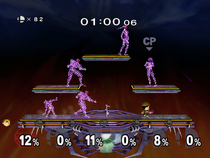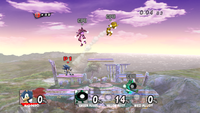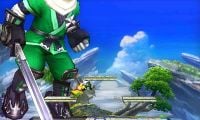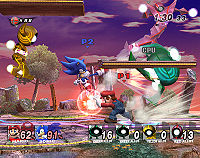Multi-Man mode: Difference between revisions
MuteSpittah (talk | contribs) mNo edit summary |
MuteSpittah (talk | contribs) (added a photo of co-op play) |
||
| Line 1: | Line 1: | ||
{{ArticleIcons|ssbm=y|ssbb=y|ssb4=y}} | {{ArticleIcons|ssbm=y|ssbb=y|ssb4=y}} | ||
[[File:SSBM Multi Man.png|210px|thumb|{{SSBM|Ness}} fights in the 100-Man Melee.]] | [[File:SSBM Multi Man.png|210px|thumb|{{SSBM|Ness}} fights in the 100-Man Melee.]] | ||
[[File:Fightingalloyteam.jpg|21-px|thumb|{{SSBB|Mario}} and {{SSBB|Sonic}} fight in Co-op 3-Minute Brawl.]] | |||
'''Multi-Man mode''' ({{ja|組み手}} ''Kumi-te'', '''Group Combat''') is a [[Stadium]] sub-mode appearing in ''[[Super Smash Bros. Melee]]'' as '''Multi-Man Melee''', ''[[Super Smash Bros. Brawl]]'' as '''Multi-Man Brawl''', and ''[[Super Smash Bros. 4]]'' as '''Multi-Man Smash'''. This sub-mode pits the player against multiple consecutive foes, challenging them to defeat as many as possible under various pretenses, while additionally allowing for more characters to be on-screen than allowed under normal circumstances. Though the player has only one stock, the enemy team often sustains high [[knockback]], has a low [[artificial intelligence]] level, and lacks the ability to perform special moves or grab ledges. Each game in the series features different [[enemy team]]s to fight against: in ''Melee'' the [[Fighting Wire Frames]], in ''Brawl'' the [[Fighting Alloy Team]], and in ''SSB4'' the [[Fighting Mii Team]]. | '''Multi-Man mode''' ({{ja|組み手}} ''Kumi-te'', '''Group Combat''') is a [[Stadium]] sub-mode appearing in ''[[Super Smash Bros. Melee]]'' as '''Multi-Man Melee''', ''[[Super Smash Bros. Brawl]]'' as '''Multi-Man Brawl''', and ''[[Super Smash Bros. 4]]'' as '''Multi-Man Smash'''. This sub-mode pits the player against multiple consecutive foes, challenging them to defeat as many as possible under various pretenses, while additionally allowing for more characters to be on-screen than allowed under normal circumstances. Though the player has only one stock, the enemy team often sustains high [[knockback]], has a low [[artificial intelligence]] level, and lacks the ability to perform special moves or grab ledges. Each game in the series features different [[enemy team]]s to fight against: in ''Melee'' the [[Fighting Wire Frames]], in ''Brawl'' the [[Fighting Alloy Team]], and in ''SSB4'' the [[Fighting Mii Team]]. | ||
Revision as of 00:58, February 20, 2016

Multi-Man mode (組み手 Kumi-te, Group Combat) is a Stadium sub-mode appearing in Super Smash Bros. Melee as Multi-Man Melee, Super Smash Bros. Brawl as Multi-Man Brawl, and Super Smash Bros. 4 as Multi-Man Smash. This sub-mode pits the player against multiple consecutive foes, challenging them to defeat as many as possible under various pretenses, while additionally allowing for more characters to be on-screen than allowed under normal circumstances. Though the player has only one stock, the enemy team often sustains high knockback, has a low artificial intelligence level, and lacks the ability to perform special moves or grab ledges. Each game in the series features different enemy teams to fight against: in Melee the Fighting Wire Frames, in Brawl the Fighting Alloy Team, and in SSB4 the Fighting Mii Team.
In Melee, Multi-Man modes are single-player endeavors, whereas Brawl allows for two-player co-op locally or in With Friends over Nintendo Wi-Fi Connection, and Super Smash Bros. 4 allows for two-player co-op locally in Super Smash Bros. for Nintendo 3DS and up to four players locally in Super Smash Bros. for Wii U. In Melee, players face up to five Fighting Wire Frames at once. In Brawl, players face up to five Fighting Alloys at once in both single-player and co-op modes. In Super Smash Bros. for 3DS, players face up to four Fighting Miis at once in single-player mode and up to three Fighting Miis at once in co-op mode, and in Super Smash Bros. for Wii U up to five Fighting Miis at once in single-player mode and up to four Fighting Miis at once in multiplayer mode.
In Super Smash Bros. 4, players are not allowed to use any customizations in Multi-Man Smash, preventing players from using equipment to augment their characters' power or bypass the game mode's restrictions. As such, excluding the Mii Fighters, fighters are only allowed to use their default special moves in Multi-Man Smash.
Multi-Man mode originates from the 10th stage of the 1P Game in the original Super Smash Bros., which takes place on Battlefield and pits the player against 30 Fighting Polygons, purple polyhedrons modeled after all 12 characters in the game. The Fighting Polygon Team cannot grab or use special moves, and have reduced power, weight, and tendencies for shielding and dodging attacks, all of which change with the set difficulty level. Battle scenarios of this nature spawned off into their own mode in Melee, appearing in every consecutive game in the series since.
List of Multi-Man modes

- 10-Man - challenges the player to defeat ten opponents. This is the shortest of all Multi-Man challenges, usually taking between 10 and 20 seconds to complete for an amateur player, though world records are all within roughly 6 and 7 seconds.
- 100-Man - challenges the player to defeat 100 opponents, which get tougher as the mode continues. This usually takes a few minutes for players to clear, and can get quite difficult towards the end of the mode. The final Wire Frame to be fought will always sustain noticeably less knockback than the others.
- 3-Minute - challenges the player to survive for 3 minutes, defeating as many opponents as possible.
- 15-Minute (Melee and Brawl only) - challenges the player to survive for 15 minutes, defeating as many opponents as possible. Foes get stronger as time passes by. Despite the difficulty, simple strategies such as spamming a certain move or evading the opponents altogether will suffice.
- Endless - challenges the player to defeat as many opponents as possible before being KO'd themselves. It has no time limit nor enemy KO limit, and as such can go on for an indefinite amount of time.
- Cruel - challenges the player to defeat as many opponents as possible before being KO'd themselves, but the opponents now have extremely high handicaps, increased aggressiveness, and a high AI level. Additionally, no items will appear. This is unarguably the most difficult Multi-Man challenge, as the opponents faced are immensely harder than those who appear in the other modes.
- Rival (SSB4 only) - challenges one player to defeat more opponents than their Rival (an AI clone of their character) before they are themselves defeated in an otherwise endless match. Rivals respawn after being KO'd. The player's final score is equal to the difference of number of opponents they and their Rival defeated. This mode replaces 15-Minute mode in SSB4.
Enemy teams
- Fighting Wire Frames (Melee) - purple-colored male and female wireframe humanoids. Male Wire Frames are based on Captain Falcon, while the Female Wire Frames are based on Zelda. They cannot charge smash attacks, and despite being based on Captain Falcon and Zelda, their attacks also have no fire, electric, or magic effects.
- Fighting Alloy Team (Brawl) - metallic fighters based on four characters in the game. Red alloys are based on Captain Falcon, Blue Alloys are based on Zelda and Zero Suit Samus, Yellow Alloys are based on Mario, and Green Alloys are based on Kirby and Jigglypuff. Despite being based on Zelda, Blue Alloys lack magic and fire attack effects. They cannot grab items nor receive giant, tiny or flower status effects. Every 25th opponent fought is spawned as a character, and the final opponent is a palette swap of the player's character.
- Fighting Mii Team (SSB4) - Mii Fighters wearing black jumpsuits with a white "M" letter printed on its anterior and two white "i" letters around their limbs. Their skin and facial appearances cull from Miis saved on the player's console, or from pre-loaded/guest Miis if there aren't enough. Despite this, their height and weight are all uniform. They can recover by footstool jumping off each other despite not being able to attack each other otherwise. Every 50th opponent fought is spawned as a giant character, and the final opponent in 100-Man Smash is a giant version of the player's character.
Items
For balancing reasons, certain items do not spawn in Multi-Man Melee and Multi-Man Brawl, and only a select few appear in Multi-Man Smash. Additionally, no items will spawn at all in Cruel mode.
- Multi-Man Melee - Food, Maxim Tomatoes, Heart Containers, Hammers, Barrels, Crates, and Party Balls do not spawn. Additionally, Capsules are always explosive and Poké Balls cannot spawn Legendary Pokémon.
- Multi-Man Brawl - Food, Maxim Tomatoes, Heart Containers, Team Healers, Hammers, Golden Hammers, Dragoon Parts, Sandbag, Barrels, Crates, Rolling Crates, Party Balls, and Smash Balls do not spawn. Capsules are always explosive and Poké Balls cannot spawn Legendary Pokémon.
- Multi-Man Smash - in the following set order, these select items float by on a platform every 30 seconds: POW Blocks, Ray Guns, Smart Bombs and Killer Eyes. No other items spawn outside of these.
Other Multi-Man scenarios
- In Super Smash Bros., Stage 10 of 1P Game is a Multi-Man match versus a Fighting Polygon Team of 30; this existed prior to the "Multi-Man" moniker that is applied retroactively to this scenario.
- Classic Mode features certain stages with Multi-Man battles versus clones of a certain character.
- In Super Smash Bros., a Yoshi Team of 18 appears in Stage 2 in 1P Game. In Melee, 10 Yoshis appear in Stage 1 of Adventure Mode and 29 Yoshi plus a giant Yoshi appear in Event 24: The Yoshi Herd. In Brawl, six Yoshis appear in Event 11: Yoshi's Rainbow and 50 Yoshis in Co-Op Event 5: The Yoshi Team of 50.
- In Super Smash Bros., Stage 7 of 1P Game features a Kirby Team of seven Kirbys with Copy Abilities plus one without a Copy Ability or a secret character. In Melee, the second part of Stage 5 of Adventure Mode is a battle against 15 Kirbys with Copy Abilities of currently available characters, and Event 28: Puffballs Unite! is a battle against 15 Kirbys with Copy Abilities as well. Event 16: Kirby's Air-raid is a battle against 10 Kirbys that can only be defeated by Warp Stars.
- In Melee, the first part in Stage 11 of Adventure Mode is a Multi-Man match with reduced gravity versus 15 giant Fighting Wire Frames.
- In Melee, the final stage of All-Star Mode is a battle against 25 Mr. Game & Watches.
- In Melee, Event 22: Super Mario 128 is a battle against 128 mini Marios.
- In Melee, Event 37: Legendary Pokémon is a match versus four giant Fighting Wire Frames and a red Jigglypuff. Poké Balls are the only items that appear, holding Legendary Pokémon or Wobbuffet.
- In Super Smash Bros. for 3DS, a Multi-Man match is one of possible Final Battles in Smash Run, where the Fighting Miis along with metal and giant metal versions of the player character appear.
Trivia

- Each member of the enemy teams in all Multi-Man modes weigh the same as Mario, except for the Female Wire Frame in Melee, who weighs the same as Zelda.
- Clearing 100-Man mode for the first time gives the player the opportunity to unlock a character: Falco in Melee and Brawl and Wario in SSB4.
- The Fighting Mii Team cannot wear hats even if the Miis their appearances are based on wear them. They also do not change their facial expressions in battle.
- The Fighting Mii Team can have varied head shapes, so when inflicted with the flower ailment, it sprouts from the back of their necks rather than from their heads.
- Prior to version 1.0.4, a glitch in Super Smash Bros. for 3DS allowed players to use Egg Lay repeatedly to increase the size of giant opponents.
- The final boss of the eShop game Kirby Fighters Deluxe, Team DDD, is modeled after Multi-Man mode, consisting of 61 Mini Dededes, two medium-sized Combo Dededes, and King Dedede himself.
| Super Smash Bros. Melee menu items | |
|---|---|
| Vs. Mode | Melee (Time · Stock · Coin Battle · Bonus · Team Battle) · Custom Rules · Special Melee · Tournament Mode · Names |
| 1-P Mode | Regular Match (Classic Mode · All-Star Mode · Adventure Mode) · Event Match · Stadium (Target Test · Home-Run Contest · Multi-Man Melee) · Training |
| Trophies | Gallery · Collection · Lottery |
| Options | Rumble · Sound · Screen Display · Language · Erase Data |
| Data | Snapshots · Melee Records · Sound Test · Archives (NTSC only) · How to Play (PAL only) |
| Unused | Debug menu · Debug sound test menu |
| Super Smash Bros. Brawl menu items | |
|---|---|
| Group | Brawl (Time · Stock · Coin Battle · Team Battle) · Rules · Special Brawl · Rotation · Tourney · Names |
| Solo | Classic · All-Star · Adventure Mode: The Subspace Emissary · Events · Stadium (Target Smash!! · Home-Run Contest · Multi-Man Brawl · Boss Battles) · Training |
| Wi-Fi | Spectator Mode · With Anyone · With Friends |
| Vault | Trophies & Stickers (Trophy Gallery · Trophy Hoard · Coin Launcher · Sticker Album · Sticker Center) · Stage Builder · Album · Challenges · Replays · Masterpieces · Chronicle |
| Options | Screen · Deflicker · Rumble · Controls · Sound · My Music · Erase Data |
| Data | Movies · Records (Group Records · Brawl Records · Notices) · Sound Test |
| Super Smash Bros. for Nintendo 3DS menu items | |
|---|---|
| Smash | Smash (Solo · Group · Time · Stock · Team Battle) · Rules |
| Smash Run | Solo · Group · Custom · Select Music |
| Games & More | Classic · All-Star · Stadium (Multi-Man Smash · Target Blast · Home-Run Contest) · Training · Custom · amiibo · Vault (Trophies · Trophy Rush · Album · Replays · Sounds · Records · Tips) · Options (Controls · Sound · Character Outline · Damage Display · Internet Options) |
| Online | Spectator Mode · With Anyone (For Fun · For Glory) · With Friends · Conquest · Share |
| Other | Challenge · StreetPass · Wii U |
| Super Smash Bros. for Wii U menu items | |
|---|---|
| Smash | Smash (Time · Stock · Coin Battle · Team Battle) · 8-Player Smash · Special Smash · Rules · Controls |
| Games & More | Classic · All-Star · Stadium (Target Blast · Home-Run Contest · Multi-Man Smash) · Training · Events · Special Orders (Master Orders · Crazy Orders) · Custom · Stage Builder · amiibo · Vault (Trophies · Trophy Rush · Album · Replays · Movies · Sounds · Records · Tips · Masterpieces) · Options (Controls · Sound · My Music · Internet Options) |
| Online | Spectator Mode · With Anyone (For Fun · For Glory) · With Friends · Online Events (Tourney · Conquest) · Share |
| Other | Challenge · Smash Tour · 3DS |
